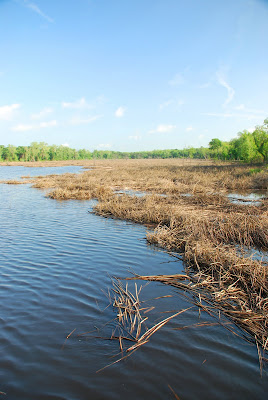
About Holla Bend NWR:
(From the Fish and Wildlife Service Website):
Holla Bend NWR, established in 1957, is located 8 miles down river from Dardanelle, Arkansas. The refuge is situated on a bend of the Arkansas River which was cut off when the U.S. Army Corps of Engineers straightened the river in 1954 for flood control. Refuge lands include over 7,000 acres of agricultural fields, bottomland forest, and open water.
The refuge's primary purpose is to provide a winter home for a portion of the millions of ducks and geese that use the Mississippi Flyway each year. During these spring and fall migrations as many as fourteen species of ducks and four kinds of geese will stop by the refuge for a short visit. During the winter, it is not uncommon for the refuge to host up to 100,000 ducks and geese at once. Bald eagles are also common in the winter from December through February.
Spring brings thousands of neotropical migratory songbirds that use the refuge as a rest area on their journey from Central and South America. Many species of vireos, warblers, buntings, and orioles inhabit the woodlands, during this time. Most only stay for a short time to rest, but others use the refuge as a nesting area. Herons, egrets, and other wading birds feed in shallow pools and alligators can be seen in the refuge lakes and ponds.
Refuge lands include agricultural fields, bottomland forest, and open waters. Portions of Holla Bend's wetlands were bottomlands surrounding remnants of the old Arkansas River channel. The largest open-water portion of the old river bed consist of approximately 390 acres. The remainder of the old channel has filled in leaving three small lakes connected by shallow willow sloughs. The other wetlands areas on the refuge consist of impoundments scattered throughout refuge farm fields. These units produce a variety of natural foods including a predominance of smartweeds, as well as sedges and panicums.
The Refuge supports a wide diversity of wildlife, including three endangered and threatened species: the bald eagle, American alligator and the Arkansas endangered barn owl. Eagles can be seen along the river and field impoundments in the winter months along with migratory and resident waterfowl. Alligators stay close to the small lakes and willow sloughs feeding on fish and unlucky wading birds. Barn owls use nest boxes under the Refuge equipment shed and their nest can be seen in thick willow stands along the old river channel. Other commonly seen wildlife species include raccoon, bobcats, deer, turkey, egrets, herons and gulls.
May 24th Tour:
A series of scattered thunderstorms were present throughout much of western Arkansas and eastern Oklahoma on May 24th. We drove through rain for the majority of our drive from Tulsa to Holla Bend. The past week had also seen a decent amount of precipitation, making for especially marshy conditions at the refuge (considering the NWR is built on a flood plain).
As we began down the main road for the refuge a pair of Wild Turkey hurriedly crossed the road 15 yards in front of us.
We decided to drive through the refuge following the auto tour path which would allow us to stop and watch the fields for birds. At our first stop we rolled down the windows so as to allow for a better view but within 30 seconds we had swarms of mosquitoes surrounding the car with a dozen making their way into the car. Given this development, we were forced to observe the refuge through the windows of the car.
On almost every stop we made one could hear the distinctive call of a Dickcissel. Often we would be able to observe the bird singing from an exposed perch on a shrub or small tree. I first encountered these fellas at Tishomingo 2 weeks ago, though they were far more abundant at Holla Bend. We also noticed a single House Finch singing from atop a stalk of grass.
While driving along the northern road we saw a single Northern Bobwhite Quail scrambling out of the path of our car and then fly several yards to a overgrown area in an adjacent field. When we stopped at the observation tower found on the western side of the refuge we could hear numerous quail vocalizing, the namesake of the bird : "b, Bob white!" . Though I have seen these before at the Nickel Preserve near Tahlequah, Oklahoma , this would be the first recorded sighting.
From the observation tower one can observe the former path of the Arkansas River, a large oxbow lake. We spotted three Great Egrets perched on a series of snags in the middle of the old river channel. As mentioned above, we could hear numerous Dickcissels and Northern Bobwhite vocalizing as we stood on the observation tower.
Several Indigo Buntings ( 3 male, 1 female) were seen throughout the drive as well as a couple of male Red-winged Blackbirds. While parked near the refuge HQ one could hear the high-pitched calls of several Blue-gray Gnatcatchers.
Location: Holla Bend NWR - Auto Tour - Dardanelle, AR
Observation date: 5/23/09 Number of species: 12
Wild Turkey - Meleagris gallopavo 2
Northern Bobwhite - Colinus virginianus 2
Great Egret - Ardea alba 3
Mourning Dove - Zenaida macroura 1
Scissor-tailed Flycatcher - Tyrannus forficatus 4
Blue-gray Gnatcatcher - Polioptila caerulea 8
Northern Cardinal - Cardinalis cardinalis 2
Indigo Bunting - Passerina cyanea 4
Painted Bunting - Passerina ciris 1
Dickcissel - Spiza americana 12
Red-winged Blackbird - Agelaius phoeniceus 2
House Finch - Carpodacus mexicanus 1
New Addition to SPQ's Lifelist:
Photos:
Top: A view of one of the many agricultural fields found throughout the refuge.
Bottom: A view of the Arkansas River's former path (Old River Channel) as seen from the observation tower.
-SPQ 5/28/2009







































































